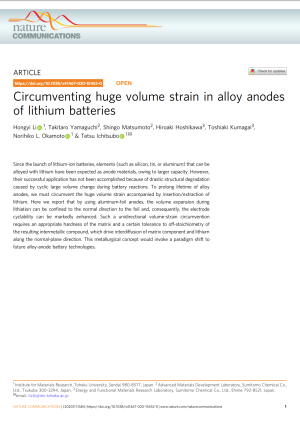東北大学と住友化学、アルミニウム負極の課題であった 充放電時の劣化の回避につながる新しい機構を解明 ~リチウムイオン二次電池の高性能化につながる新しい負極の実現へ~
Nature Communications 11, 1584 (2020)
2020年4月27日 11:00 | プレスリリース・研究成果
【ポイント】
●炭素系負極に比べて数倍のエネルギーを蓄えられるアルミニウム負極について、課題であった充放電時の体積膨縮を、高純度アルミニウム箔の使用により制御できることを見いだし、その機構を解明した
●さらに、従来の負極は、リチウムイオンを蓄える機能の炭素系材料と、電流を集め基材の機能も果たす銅箔の積層構造とする必要があったが、高純度アルミニウム箔の使用により双方の役割を両立する「一体型負極」となることを突き止めた
●これらの成果は、電池の製造工程の大幅な簡素化と高性能化に貢献するものである
【概要】
国立大学法人東北大学金属材料研究所の李弘毅特任助教、市坪哲教授をはじめとする研究グループ、および住友化学株式会社(以下、「本研究グループ」)は、2019年4月より連携して、リチウムイオン二次電池の高容量化のための新しい負極の研究開発を行ってきました。その成果として、このたび、負極の材料を高純度アルミニウム箔のみで、充放電時に起こる巨大体積ひずみを回避するという、新しい機構を解明いたしました。
リチウムイオン二次電池は、正極、負極、電解質およびセパレータの主要4 部材から構成されており、リチウムイオンが正極と負極間を移動することで充放電が行われ、負極は、充電時に正極から移動してきたリチウムイオンを取り込む役割を果たしています。現在の負極は炭素系材料が主流ですが、電池のさらなる高容量化のために、炭素系材料に比べて3~10倍のエネルギーを蓄えられるシリコンのほか、スズやアルミニウムなどの金属系材料の使用が期待されています。しかし、それらの材料は、多くのリチウムイオンを取り込み大きなエネルギーを蓄えられる反面、充放電時に2~4 倍も膨縮するため内部の電極構造が崩れやすい点が、実用化の課題となっていました。
今回、本研究グループは、高純度アルミニウム箔の硬さを最適化することにより、課題であった充放電時の体積膨縮の制御が可能なことを見いだしました。本研究は、東北大学金属材料研究所の物質・材料に関する科学の力と、住友化学が長年にわたり高純度アルミニウム事業で培ってきた技術の融合により解明が出来たと考えています。一体型アルミニウム負極の実現により、従来のリチウムイオン二次電池に比べて、電池製造のプロセスを大幅に簡素化できることから、製造工程における環境負荷の低減とともに、高容量化や軽量化、低価格化なども期待できます。また、次世代電池として注目される全固体電池にも、本研究の成果を適用できる可能性があります。
東北大学金属材料研究所と住友化学は、引き続き、一体型アルミニウム負極の実現に向けて研究開発に励み、持続可能な社会の構築に取り組んでまいります。
本成果は、「Nature Communications」誌に4月13日付けでオンライン掲載されています。
DOI: https://doi.org/10.1038/s41467-020-15452-0
Circumventing Huge Volume Strain in Alloy Anodes of Lithium Batteries
2020/04/27
Summary
●Discovered that the use of high purity aluminum foil can successfully control the huge volume expansion/contraction of high capacity aluminum anodes during charge/discharge processes, and clarified its mechanism.
●Determined that high purity aluminum foil can be an “integrated anode”, which can replace two components of the conventional graphite anode, i.e., a layered structure of carbon material (that accommodates lithium ions) and copper foil (that functions as a substrate to collect current) as it plays the roles of both components.
●Contributed to higher performance and significant simplification of the battery manufacturing process.
Abstract
Research Assistant Professor Hongyi Li and Professor Tetsu Ichitsubo et al. at Institute for Materials Research, Tohoku University and researchers at Sumitomo Chemical have jointly undertaken the research and development of novel anodes for higher capacity of lithium-ion rechargeable batteries since April 2019. This joint research group has successfully elucidated a new mechanism for circumventing the huge volume strain during charge/discharge battery reactions with the use of a high purity aluminum foil alone as anode.
Lithium-ion rechargeable batteries consist of four components: a cathode, an anode, an electrolyte, and a separator film. Lithium ions move between the cathode and anode when the battery is charged or discharged; when charging, the anode takes in the lithium ions released by the cathode, and the reverse when discharging. Carbon-based materials are currently the mainstream for anodes. However, the use of silicon or metals such as tin and aluminum, has been considered as promising anode materials for high energy-density batteries because these materials can store three to ten times more lithium ions than the same weight carbon-based materials. Despite the higher capacity for absorbing more lithium ions, the application of metal anodes has been deadlocked because their huge volume changes (two to four times) can destroy the anode’s structure.
The joint research group has discovered that optimizing the hardness of high purity aluminum foils can control volume changes, thereby finding a solution to this long-standing issue. This discovery was made possible by integrating the excellent materials science capabilities of the Institute for Materials Research, Tohoku University and the excellent technologies that Sumitomo Chemical has cultivated to date through its high purity aluminum business. As the integrated aluminum anode can dramatically streamline the manufacturing process of lithium-ion batteries, the two organizations expect that this will reduce impacts on the environment while allowing for the creation of higher capacity, lighter weight, and lower priced lithium-ion rechargeable batteries. These research results can also be applied to next generation solid-state batteries, dual-ion batteries, etc.
Institute for Materials Research, Tohoku University and Sumitomo Chemical will continue their joint research efforts toward practical implementation of the integrated aluminum anode and contribute to the development of a sustainable society.
The research was published in Nature Communications (online version, April 13, 2020)

